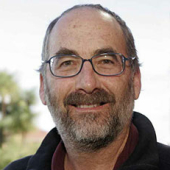
Quantifying the efficacy and environmental impacts of large scale macroalgal cultivation and purposeful sequestration
David Siegel, Professor, UC Santa Barbara, USA

Quantifying the efficacy and environmental impacts of large scale macroalgal cultivation and purposeful sequestration
David Siegel, Professor, UC Santa Barbara, USA
About the speaker:
David Siegel is an interdisciplinary marine scientist working on a wide range of problems from quantifying the functioning of the ocean’s biological carbon pump to role of climate variability on kelp forest population ecology to developing new remote sensing tools to assess ocean phytoplankton distributions and kelp canopies. Professor Siegel received his undergraduate degrees from the University of California, San Diego and graduate degrees from the University of Southern California. In 1989, he was a postdoctoral fellow at the Woods Hole Oceanographic Institution. Since 1990, he has been on the faculty at the University of California, Santa Barbara where he is now a Distinguished Professor. Professor Siegel is a fellow of both the American Geophysical Union and the American Association for the Advancement of Science.
Company info:
University of California, Santa Barbara is a public research 1 university that is part of the UC system.
Presentation:
In this talk, I will provide initial results from our ARPA-E funded study on the efficacy and environmental impacts of large scale macroalgae cultivation and purposeful sequestration as an ocean-based CO2 removal (CDR) strategy. Our study is focused on Giant Kelp grown and sequestered in the Southern California Bight. The study links field and laboratory experimentation with regional and global oceanographic models focusing upon the fates of macroalgal carbon (both sequestered biomass and exuded dissolved organic matter), the net impacts of large scale kelp cultivation on ocean biogeochemical cycles and the durability of purposeful sequestration as a function of conveyance.
Interview:
1. When was the first time you got involved with seaweeds and why?
I am a PI on the US NSF-funded Santa Barbara Coastal Long Term Ecological Research site, which focuses on the Giant Kelp forest ecosystem off the Santa Barbara coast (https://sbclter.msi.ucsb.edu/). We are in our 23rd year in this program. My initial contributions were as a classic oceanographer tasked with quantifying the ecological subsidies from the coastal ocean to kelp forests. Along the way, my students, Kyle Cavanaugh and Tom Bell, and I found that Landsat satellite data were great for mapping out giant kelp forest distributions over local (30 m) to near-global (1000’s of kms) scales with a data set that goes back 40+ years. This enabled us to work on a wide variety of ecological issues from diagnosing the spatial metapopulation dynamics of kelp forests to understanding the roles of intrinsic vs. extrinsic factors regulating Giant Kelp population dynamics. These accomplishments led us to our involvement in ARPA-E’s MARINER program where we were funded to develop above and in water remote methods for monitoring kelp farm operations. Guess it just was a series of discoveries and opportunities that has brought me along this path.
2. What is your view on the US seaweed industry in 2030?
Wow. 2030 is like tomorrow. And there’s a lot to do… I think a lot comes down to resolving two science / technological issues. First, we need improved scientific understanding whether large-scale seaweed cultivation can substantively contribute to a viable offshore biofuel market and whether seaweed purposeful carbon sequestration can contribute to the net negative emissions required to keep the Earth’s temperatures close to the 2C warming cap of the Paris accord. There are many open science questions that need to be answered today - effects of large-scale seaweed aquaculture on the marine environment, whether seaweed carbon sequestration will actually work in net, etc. These studies can and must be conducted today.
The second major issue is to develop the means enough seaweed to help solve these global problems. For example, to contribute just 1% of the required 10 GT CO2/y of net negative emissions, vast amounts of the ocean need to be farmed (roughly 100,000 km^2 or 10 million hectares) as reported by the recent National Academy Study. This is more than 50 times the area in seaweed aquaculture today and roughly six-fold greater than the farmed area projected in 2050 by Duarte et al. (2021). To get to these goals, the technical / logistical challenges here are immense. ARPA-E’s MARINER program is a step towards this goal. But the shear immense size of the challenge means we need to keep investing today if we are to meet these challenges, assuming of course that aquaculture seaweed is a viable contributor to these two major issues facing humankind.
3. What will you be talking about at Seagriculture USA 2023?
I will be talking about our ARPA-E funded project to assess the efficacy and environmental impacts of large-scale seaweed aquaculture and purposeful carbon sequestration (https://seaweedcdr.eri.ucsb.edu/). Our project goals are to understand on local to basin scales how large-scale seaweed cultivation affects the ocean environment, what happens to seaweed biomass once it is conveyed to depth, how long the sequestered biomass remains out of contact with the atmosphere and to answer whether seaweed is a viable contributor to global negative net greenhouse gas emissions.